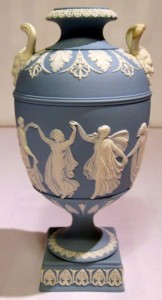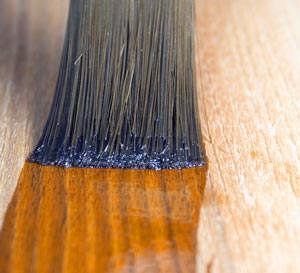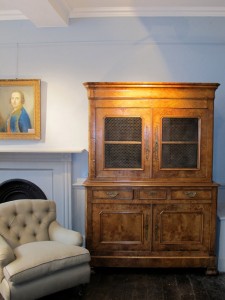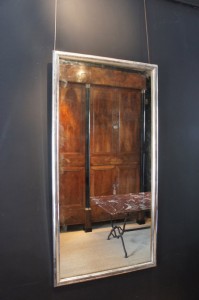Legend of the Nymphenburg “Kings Service”
September 28th, 2012 by adminLegend of the Nymphenburg Porcelains Works starts with the designs of Dominikus Auliczek. He was born in East Bohemia on August 1, 1734. Following an apprenticeship in Litomyšl, Auliczek travelled to Vienna, Paris, London and Rome to refine his skills as a sculptor. He was awarded first prize of the Accademia di San Luca for his modelling work by Pope Clemens XII. Auliczek came to Munich in 1762, as one of the best in his field.
It was in 1763, he commenced work for Porcelain Works-Studio Nymphenburg as the successor to Franz Anton Bustelli. In 1772, he advanced to become royal sculptor to the Bavarian electoral court. He created around 100 figures as the model maker during this period. From 1773 to 1797, he headed manufacture as inspector and subsequently as the artistic director (until his death in 1804).
Initially, still strongly influenced by the late-baroque buildings and structures he encountered on his travels in Italy, he created statuesque figures of the gods and a monumental table piece. The most pioneering design by Dominikus Auliczek is the PEARL service held in the Louis-Seize style, which was initially created at the porcelain manufactory for Elector Carl Theodor of Bavaria (around 1793).
These works has been produced for over the past 100 years plus, this service was reserved exclusively for the court of the Wittelsbach family. The name of PEARL is derived from the fragile bar of pearl that lines each individual object. For the first time in the history of porcelain in Europe, Auliczek based his service on the shape of a dodecagon.
Lovingly artisans applied with 792 different sepia veduta and lavish blue-gold decorations, the service was produced in 1918 for the golden wedding anniversary of King Ludwig III and Archduchess Marie Therese as a gift from their children and has, since this time, been known as the “Royal Bavarian Service”.
The painted decoration consists of small oval and round landscape reserves in grey or sepia (tone-in-tone painting) with a few trees in the foreground, sometimes with a building as a “view ” and in some cases adorned with small figures of people in the spirit of Jacques Callot’s etched scenes . Even today these works are highly sought after as so many of the fine works of the Nymphenbury Porcelains factory in different variations based on original layouts dating from the 18th century.
The Nymphenburg Porcelain Manufactory (in German: Porzellanmanufaktur Nymphenburg), manufacturer of Nymphenburg porcelain, is situated in the Nymphenburg Palace in Munich, capital of Bavaria, and since the mid-eighteenth century has been manufacturing porcelain of high artistic value.
After his accession in 1745 Maximilian III Joseph, Prince-Elector of Bavaria, commanded the establishment of manufacturing companies in order to bail out the state finances. From 1747 attempts were made to manufacture porcelain and at the end of that year the former Neudeck Castle in the area now the Munich suburb of Au-Haidhausen was made available for that purpose. Up to 1754 the experiments were a miserable failure and lost considerable amounts of money, but in that year the efforts to manufacture porcelain finally began to succeed. In 1755 the factory received its first commission from the Bavarian court and in 1756 came the first success in painting the porcelain in color. The management of the jurist and entrepreneur Count Sigmund von Haimhausen from 1758 ensured that the factory was placed on a sound commercial footing. By 1761 it had moved to the Nymphenburg Palace, where it still is today.
Among the great artists who followed Bustelli were Dominikus Auliczek the elder (1734—1804) and Johann Peter Melchior. A great promoter of the works was Ludwig I who gave them many commissions. Particular favorites were dinner services with copies of famous paintings or with Bavarian landscapes in an antique style.
In 1822 Friedrich von Garner, the fashionable architect, was appointed artistic director of the factory. In the middle of the 19th century, its financial position deteriorated to the extent that in 1856 all artistic production was halted and it was decide to privatize the factory. It was leased out for the first time in 1862 and its focus shifted to the production of technical, medical and sanitary porcelain goods.
In 1887 Albert Bäuml (1855—1929) took a lease of the factory. His aim was to regain the previous high artistic level of the factory’s products: it was Bäuml, for example, who “rediscovered” Bustelli. This aim was realized at around the turn of the 19th and 20th centuries and besides historical copies, elegant Jugendstil ceramics were developed.
Works of the Nymphenberg Porcelains work can be seen and appreciated at;
James Stow & Anthony Yau
Candlewood Yankee Fine Arts



 Over the years, antiques have been passed down from generation to generation, from one antique shop to the next, and from flea markets all over the world to your home. With the volume of households antiques have been in over the last 50-100 years, is it any wonder any of it is still in mint condition?
Over the years, antiques have been passed down from generation to generation, from one antique shop to the next, and from flea markets all over the world to your home. With the volume of households antiques have been in over the last 50-100 years, is it any wonder any of it is still in mint condition?
